2018-06-28 to 2018-07-01 General Assembly 2018 - 150th celebration
In Calgary, Alberta, the RASC executive director Randy Attwood and RASC outgoing president Colin Haig (your author) shared more about this special 150th project with a few hundred people in attendance at the conference.
On June 30th, Paul M sent us two images taken the previous night.
This test image of the Crescent Nebula was a single 30 minute exposure taken through the telescope prime focus on the loaner STL11000 camera with the Hydrogen-alpha (deep red) filter on June 29th. The image was dark-subtracted to get rid of noisy pixels, and no other processing.
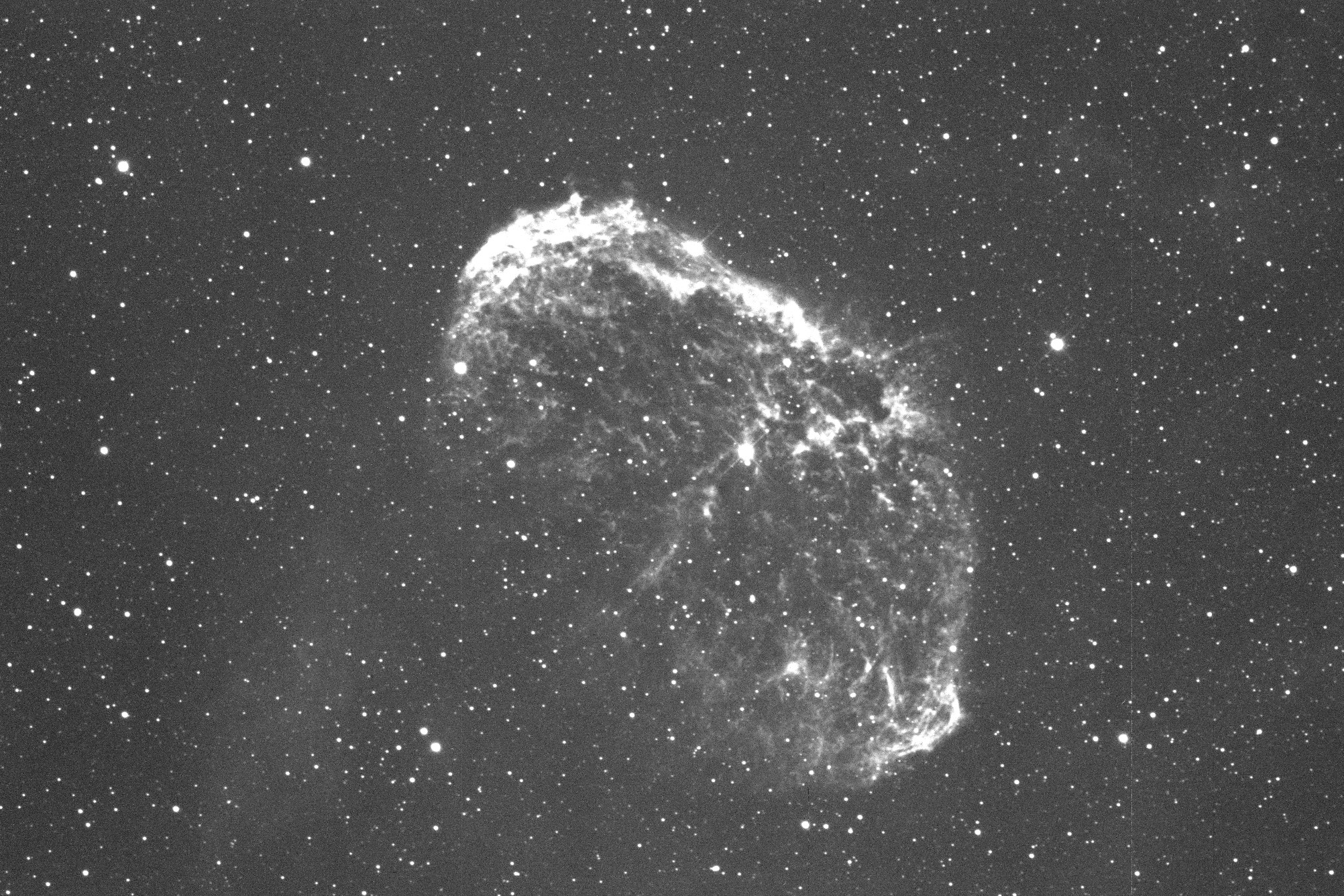
This impressive colour image below was taken with Colin's Canon 6D Digital SLR and a 200mm f/2.8 lens that rides on top of the telescope. It has a much larger field of view, and takes colour images. Paul did a quick correction in Adobe Photoshop.
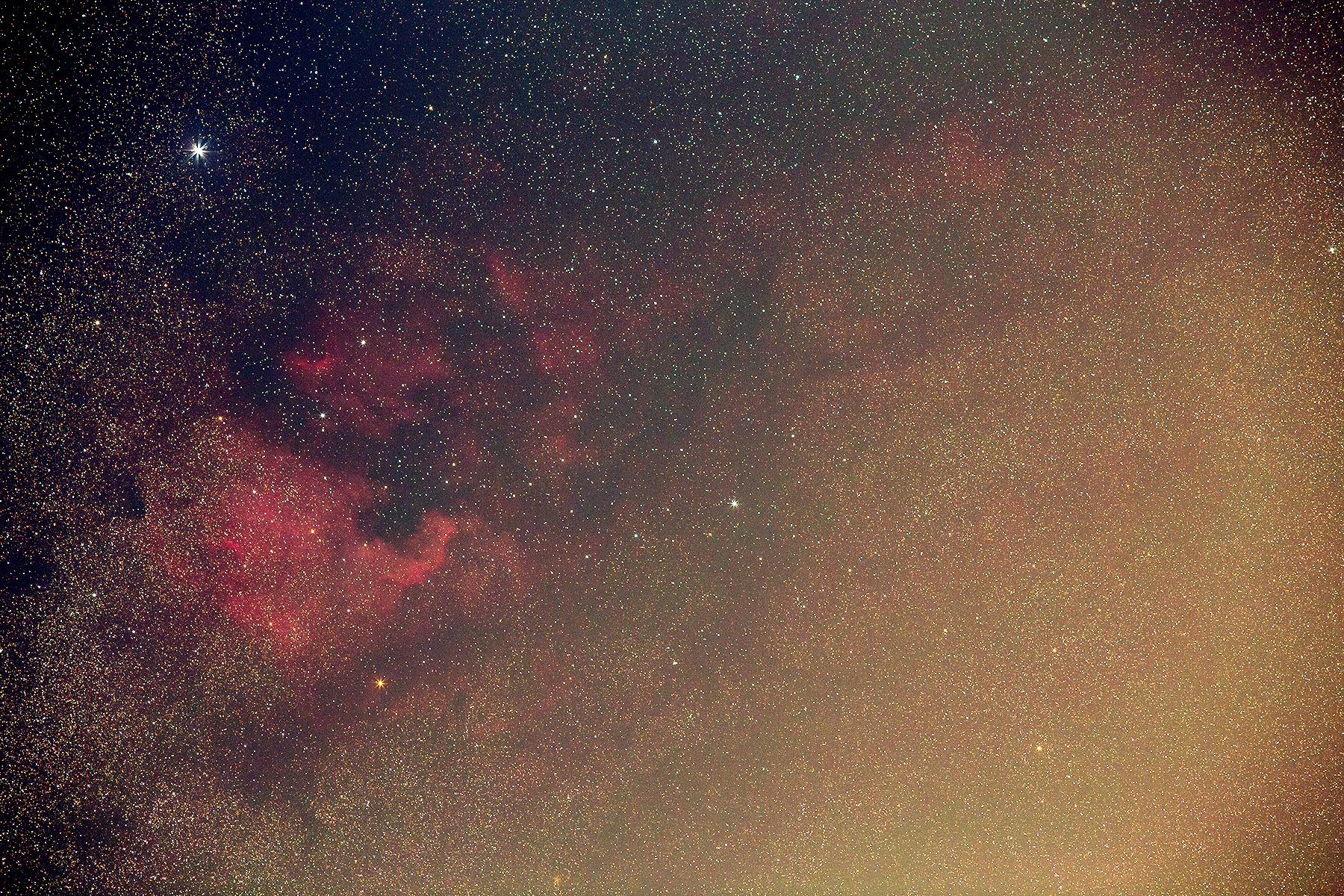
Colin asked the crowd for their feedback, and as a result, will likely donate the camera and lens (about CAD$2700) to the project in the coming months.
We are anxiously awaiting the arrival of the SBIG Imaging Systems STX16803 CCD camera from one of our key supporters, the fine people at Diffraction Limited. Due to the high demand and rarity of the high-end components, we knew it could be weeks before the camera would ship, and they kept us up-to-date. Thanks Diffraction Limited !
2018-06-27 Weather Server Improved
We are connected to a new weather server, shared by JPL and other organizations. Working well.
2018-06-25 The Eagle Nebula
The Eagle has landed. Almost. This image of M16 is a single 5-minute, unguided exposure, with dark and bias calibration. The image was taken on the 21st, and the improved pointing model is a success.
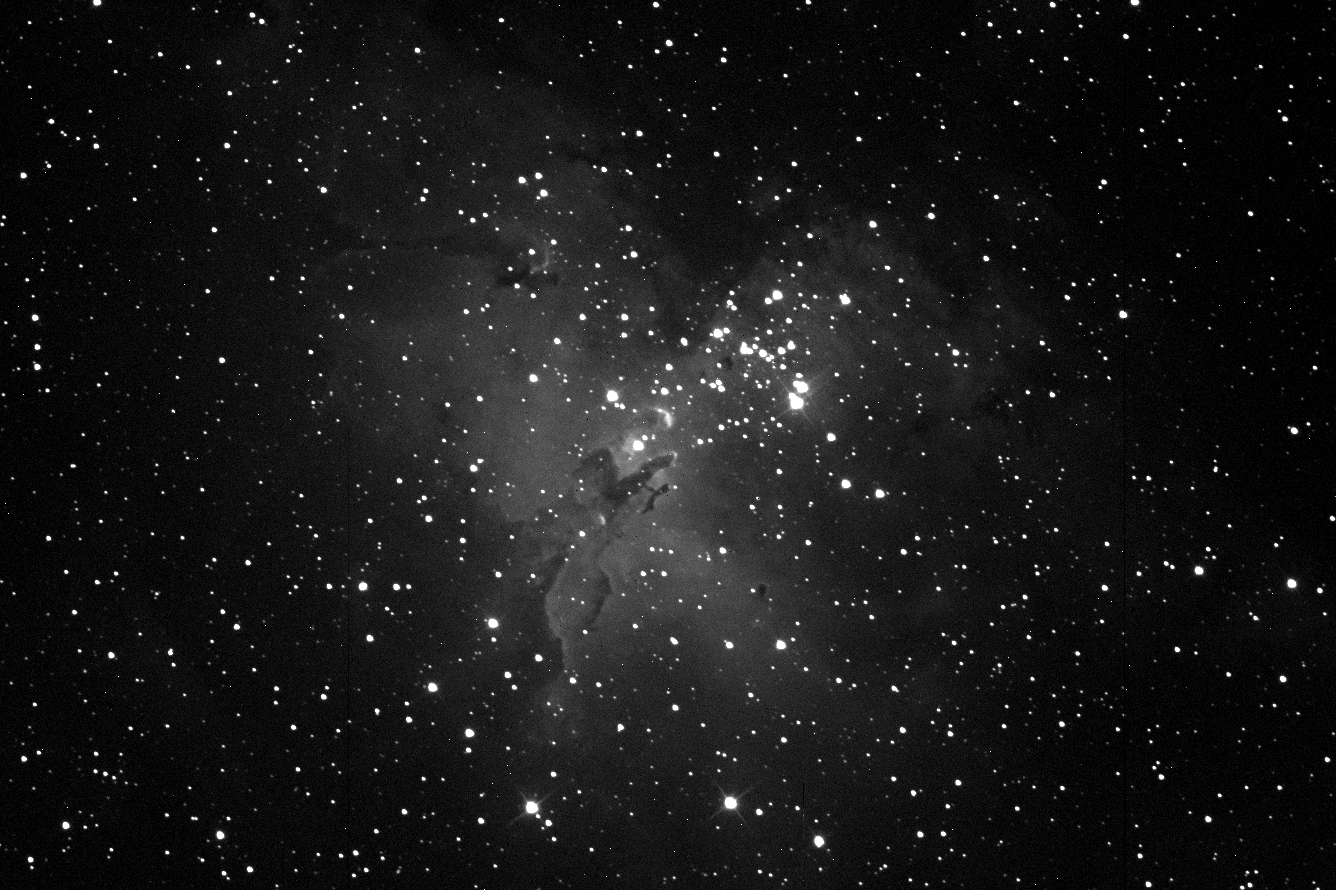
2018-06-23 New Weather Report
As an improvement to the weather monitoring at Sierra Remote Observatories, there is a new weather snapshot with a lot more detail than the old version:
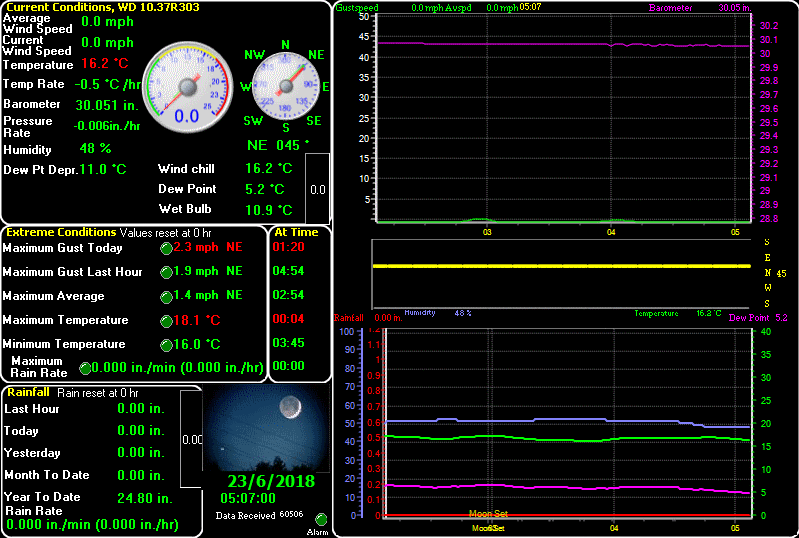
Weather data including trends and additional info like the Moon Set time is very important for the operation. Changes to the weather monitoring system require minor software configuration changes for our setup. Until that is done and tested, we have to pause some of our efforts and keep the telescope safe.
2018-06-22 Keeping our Telescope (and our Planet) Safe
Sierra Remote Observatories has automated monitoring to keep the keep the equipment safe. For example, there is a weather monitoring system that prevents the roof from opening, or closes it if the weather is getting worse. There are sensors for temperature, wind speed, humidity, and cloud cover. Windy days, rain (which is quite rare), and heavy dew are all good reasons to button up the roof.
SRO monitors electrical power as well. We received an email at about 1:30am today (Friday, the 22nd) advising that they would be pro-actively keeping the roof closed due to power concerns affecting electric utility customers including SRO in that part of California. This pro-active approach is very reassuring.
Equipment safety is a priority for SRO. Planetary safety should be a priority for everybody. Professional astronomers at the Harvard-Smithsonian Center for Astrophysics operate the Minor Planet Center. According to the MPC website , the organization is "responsible for the designation of minor bodies in the solar system: minor planets; comets; and natural satellites. The MPC is also responsible for the efficient collection, computation, checking and dissemination of astrometric observations and orbits for minor planets and comets".
Astronomers use this data to know where asteroids are and any objects that could come close to the Earth can be tracked. It is crucial to predict potentially damaging impacts.
The MPC shares this data. After downloading it and a few minutes work processing it, the latest data for comets and minor bodies is now available for use in our ACP Observatory Control Software. Here's a sample using one of our members who just happens to have an asteroid named after him:
Jameshesser: Desig = 39791 Epoch = 2458200.5 (Julian) Mean Anomaly = 116.25746 Mean Daily Motion = 0.36297844 (deg/day) Semimajor Axis 1.9463256 (AU) Orbital Eccentricity = 0.1047371 Arg. of Perihelion = 279.10744 (deg) Long. of Ascensing Node = 150.54706 (deg) Inclination = 23.61005 (deg)
Jim Hesser served as our Honorary President for several years, in addition to having a lengthy career as a professional astronomer who made significant contributions to Canadian astronomy. He's still quite active in the RASC and professional community.
Equipped with this data, our users can make observations of minor bodies, and perhaps keep our planet a little bit safer. You could, for example, schedule an image set for "jameshesser" a.k.a. "MP39791".
2018-06-21 Targets in the cross hairs
After review of the TPoint model yesterday, it was time to test out the pointing with some real images taken around 4:30am EDT/1:30am PDT. You can see here that the galaxy M81 and open cluster M4 are close to centre, but not perfect.
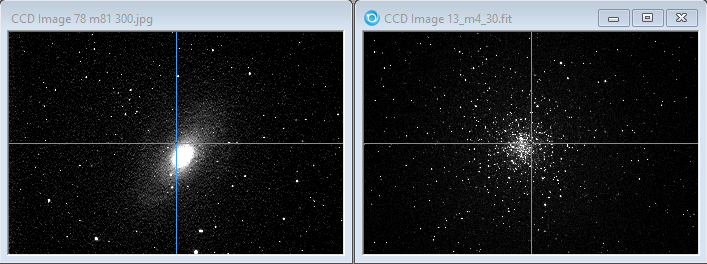
The results were sufficient to start mapping the local horizon for trees, buildings, and other obstacles. We'll use this later on to set some practical limits on where in the sky we can get images without obstructions.
During the test run, I found it hard to picture how low in the sky the Big Dipper and northerly objects would appear over the local horizon. The southerly latitude of the site in California at 37N is 12 degrees lower than most Canadians from the western provinces would have grown up with.

A small image of the M101 spiral galaxy showing beautiful spiral arms.
2018-06-20 Pointing Accuracy and the only Super Model in Astronomy
Several of the images we've taken so far have shown the object of interest is slightly off-centre. So we started work to improve the pointing of the telescope.
This cropped image of M24 shows the open cluster and a few bright field stars.
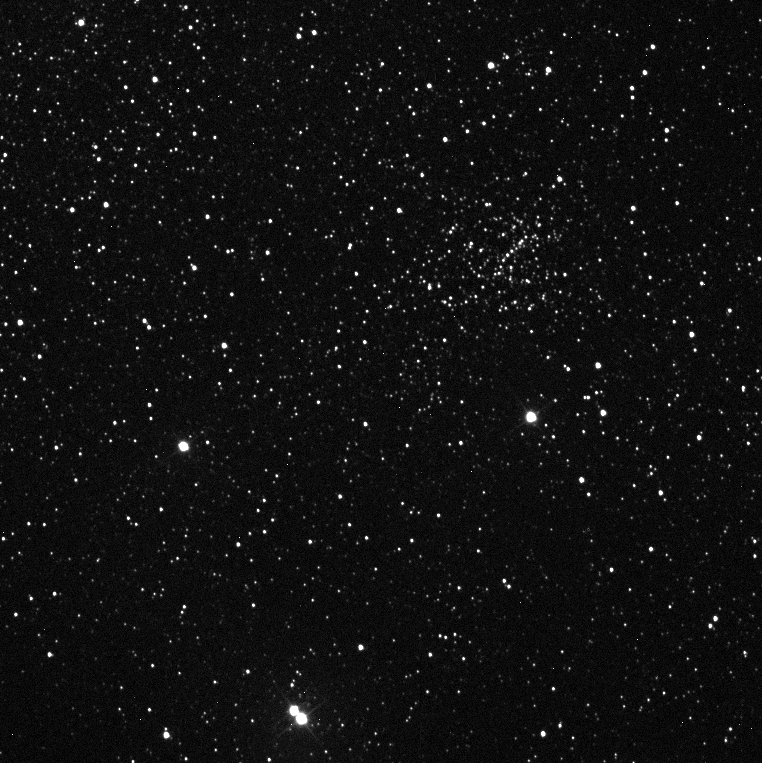
Ideally, we'd want that object in the centre of the field. It is a real challenge is to ensure that any telescope is pointing correctly. To adjust for this, we use the TPoint feature of Software Bisque's TheSky X Professional telescope control software.
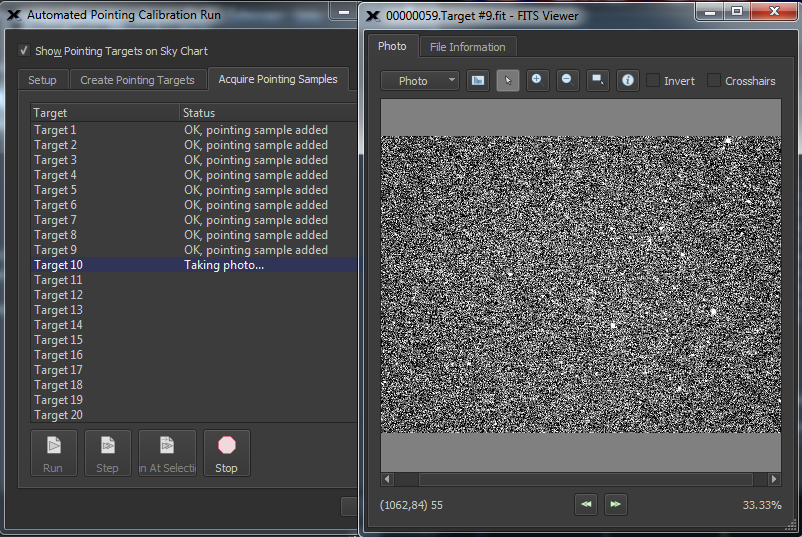
With a bit of startup help from us humans, the Automated Calibration Run will take snapshots of about 60 points in the sky with the SBIG CCD Camera. It then figures out where the stars are, the brighter points in the image, and through a technique called "plate solving" maps the detected stars against a database of charted stellar positions. At the end of the process, we know how much to correct for any inherent pointing errors.
How do we do that correcting? With the help of a Super Model of course!
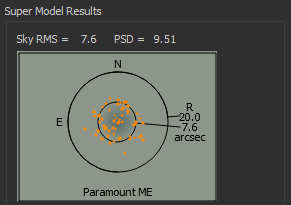 Super Model? Not a Tyson Beckford, Ashley Graham, or Cindy Crawford. A mathematical model of all of the ways error can creep in to impact the pointing accuracy of the telescope. In our case, we took an initial star position, measured it to be out of alignment, made a correction, and then took 60 additional points around the sky. Using the TSX TPoint Super Model capabilities, it calculates the amount of correction needed for each direction that the Paramount ME will point.
Super Model? Not a Tyson Beckford, Ashley Graham, or Cindy Crawford. A mathematical model of all of the ways error can creep in to impact the pointing accuracy of the telescope. In our case, we took an initial star position, measured it to be out of alignment, made a correction, and then took 60 additional points around the sky. Using the TSX TPoint Super Model capabilities, it calculates the amount of correction needed for each direction that the Paramount ME will point.
After the Tpoint calculations are complete, we can generate a Super Model, which will refine the error corrections to the mathematical model. In the results graph shown above, you can see our telescope will generally point within 7.6 arc seconds. This good result gives us confidence that the mount is running well. With a bit of effort, we may be able to improve this further. That will involve mechanical adjustments to eliminate any flop, misalignment, flexure, and other imperfections. Gathering additional Tpoint samples will improve the model further.
The Polar Alignment report is good, and it may not be worth trying to improve.
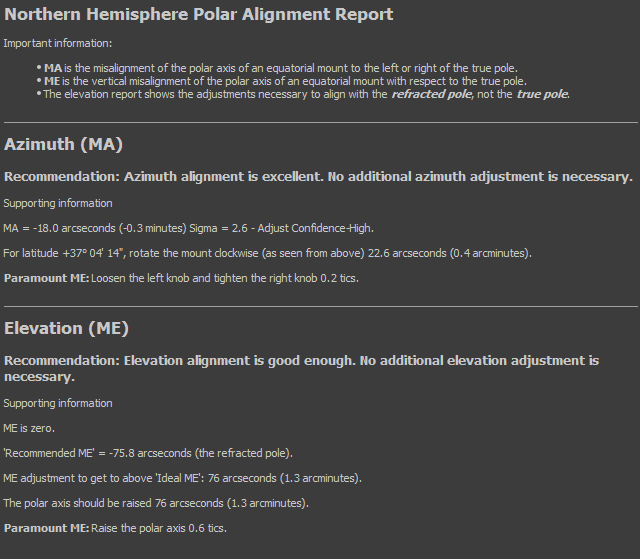
The adjustment to raise the polar axis is very small, and we'll consider making that adjustment.
2018-06-12 Digital Single-Lens-Reflex Camera
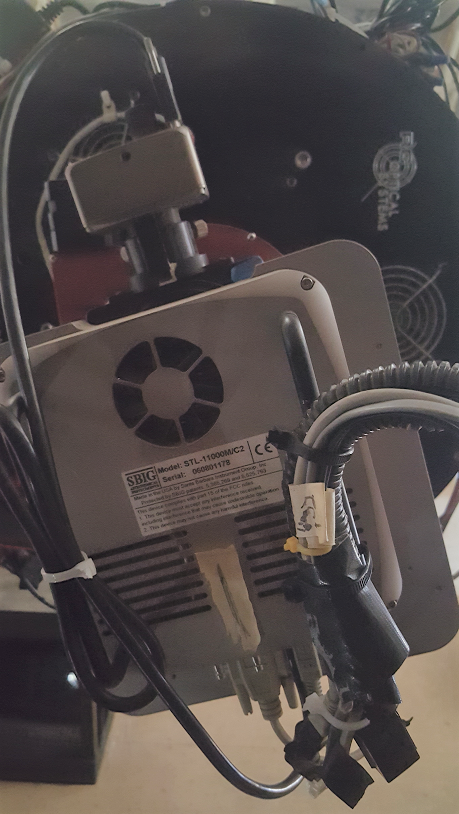 Fundraising continues, with donations coming in daily. We're all very excited about this project, and are glad people like you are supporting us!
Fundraising continues, with donations coming in daily. We're all very excited about this project, and are glad people like you are supporting us!
On a technical note, Sierra Remote Observatories helped install an improved power adapter for the Digital SLR camera, and a dew heater strap for the 200mm f/2.8 lens.
A potential cabling issue with the precision instrument rotator was hopefully resolved.
2018-06-11 TheSkyX Pro update and Pointing tests
A new "daily build" of TheSkyX Pro was installed. The telescope is pointing fairly well, and will need some refinement over several more nights. A slight adjustment to the polar alignment to ensure stars don't trail will be needed once we have an improved pointing model.
A test shot of the Veil Nebula in Cygnus shows the star slightly off centre, and a trace of faint nebulosity. We need to improve pointing further.

2018-06-06 Power under control
We now have software control of the AC power outlets, and can reboot any piece of equipment without manual intervention. This will come in handy for sequencing a proper startup and shutdown once we've finished setting up the ACP automation software.
